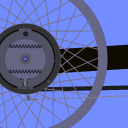Image:
 Author: bomber Group: Default Filesize: 156.28 kB Date added: 2013-11-17 Rating: 5 Downloads: 2619 Views: 442 Comments: 6 Ratings: 1 Times favored: 0 Made with: Algodoo v2.2.3 Tags:
|
Use the "Drag Tool" (D) or press the arrow keys to move the wheel and pedal.
Note that any braking action is true, showing accurately the actual mechanism. To prove this, use the "View Forces".
Experiment changing the friction lining of shoes.
Some parts have been moved back for better viewing system. |
Last edited at 2025/05/01 04:39:49 by bomber
Please log in to rate this scene |